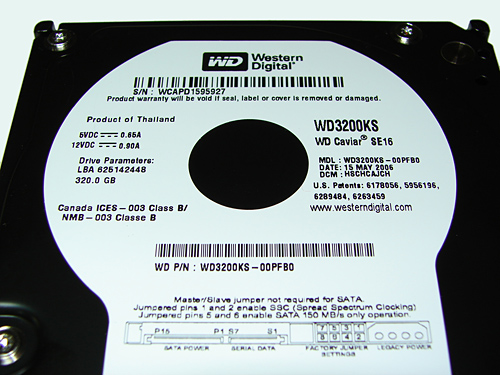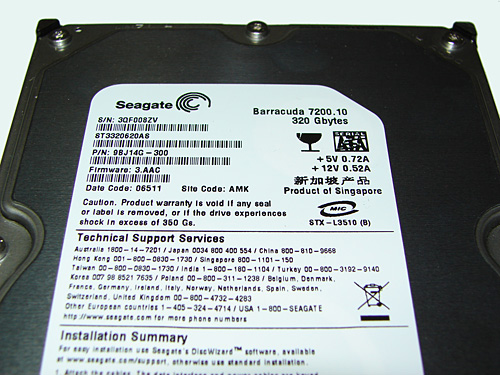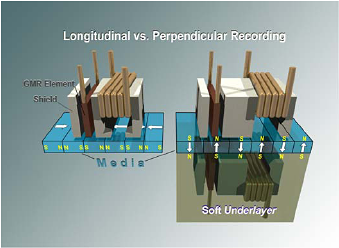Western Digital and Seagate: 320GB Grudge Match
by Gary Key on July 27, 2006 2:00 AM EST- Posted in
- Storage
Western Digital was founded in 1970 and began designing and manufacturing hard drives in 1988. The company is headquartered in Lake Forest, California, and employs approximately 23,000 people worldwide. Their innovative manufacturing facilities are located in Malaysia, California, and Thailand with research and design facilities in California.

We are looking at Western Digital's WD3200KS product today that features a 16MB drive buffer, native 3Gb/s SATA support, 320GB capacity, and 7200 RPM spindle speeds. The SE16 series is available in 250GB, 320GB, 400GB, and 500GB capacities and is considered to be Western Digital's High Performance desktop series. This series also features WD's advanced acoustic technologies, Whisperdrive and Softseek. The 400GB drive offers 1.5Gb/s SATA support while the other drives offer 3Gb/s SATA support but lack Native Command Queuing as Western Digital believes this technology does not benefit the typical desktop user.
Seagate was founded in 1979 and manufactured the first hard drive for the personal computer in 1980. The company is headquartered in Scotts Valley, California with research and design facilities in the US, Northern Ireland, and Singapore. Manufacturing and customer service sites are located in: California; Colorado; Minnesota; Oklahoma; Northern Ireland; China; Malaysia; Singapore and Thailand.

Seagate recently announced the Barracuda 7200.10 as the successor to their Barracuda 7200.9 series. The Barracuda 7200.10 series consists of drives ranging in capacity from 200GB to 750GB along with UltraATA/100, SATA 1.5Gb/s, or SATA 3Gb/s interfaces and 8MB or 16MB of cache depending upon the drive model. As with previous Barracuda product group updates the naming succession follows the standard point upgrade path but this change is anything but a simple number revision. The new Barracuda 7200.10 product is the first desktop centric hard drive to feature perpendicular recording.
What is Perpendicular Recording Technology? Simply put, during perpendicular recording the magnetization of the disc stands on end, perpendicular to the plane of the disc, instead of lying in the disc's plane as it does in current longitudinal recording. The data bits are then represented as regions of upward or downward directed magnetization points. The media is written to a soft magnetic under-layer that functions as part of the write field return path and basically generates an image of the recording head that doubles the available recording field resulting in a higher recording density compared to longitudinal recording.

Whereas in longitudinal recording, the data bit magnetization lies in the plane of the disc and switches between pointing in the same and then opposite directions of the head movement. In order to increase areal densities and provide greater storage capacity in longitudinal recording, the data bits must be arranged and shrunk in a very tight pattern on the disc media. However, if the data bit becomes too small, the magnetic energy holding the bit in place can become so small that thermal energy can cause it to demagnetize resulting in a condition known as superparamagnetism.
To avoid superparamagnetism, engineers have been increasing the coercivity, the field size required to write a bit, of the disc media. These fields are limited by the magnetic materials making up the write head that will soon effectively limit drive sizes utilizing longitudinal recording. Although additional capacities are still achievable, the drive industry will be moving to perpendicular recording technology shortly as longitudinal recording has basically hit the proverbial brick wall after being utilized for nearly 50 years.
Let's see how these two impressive drives compare to each other and if a knockout is in store.

We are looking at Western Digital's WD3200KS product today that features a 16MB drive buffer, native 3Gb/s SATA support, 320GB capacity, and 7200 RPM spindle speeds. The SE16 series is available in 250GB, 320GB, 400GB, and 500GB capacities and is considered to be Western Digital's High Performance desktop series. This series also features WD's advanced acoustic technologies, Whisperdrive and Softseek. The 400GB drive offers 1.5Gb/s SATA support while the other drives offer 3Gb/s SATA support but lack Native Command Queuing as Western Digital believes this technology does not benefit the typical desktop user.
Seagate was founded in 1979 and manufactured the first hard drive for the personal computer in 1980. The company is headquartered in Scotts Valley, California with research and design facilities in the US, Northern Ireland, and Singapore. Manufacturing and customer service sites are located in: California; Colorado; Minnesota; Oklahoma; Northern Ireland; China; Malaysia; Singapore and Thailand.

Seagate recently announced the Barracuda 7200.10 as the successor to their Barracuda 7200.9 series. The Barracuda 7200.10 series consists of drives ranging in capacity from 200GB to 750GB along with UltraATA/100, SATA 1.5Gb/s, or SATA 3Gb/s interfaces and 8MB or 16MB of cache depending upon the drive model. As with previous Barracuda product group updates the naming succession follows the standard point upgrade path but this change is anything but a simple number revision. The new Barracuda 7200.10 product is the first desktop centric hard drive to feature perpendicular recording.
What is Perpendicular Recording Technology? Simply put, during perpendicular recording the magnetization of the disc stands on end, perpendicular to the plane of the disc, instead of lying in the disc's plane as it does in current longitudinal recording. The data bits are then represented as regions of upward or downward directed magnetization points. The media is written to a soft magnetic under-layer that functions as part of the write field return path and basically generates an image of the recording head that doubles the available recording field resulting in a higher recording density compared to longitudinal recording.

Whereas in longitudinal recording, the data bit magnetization lies in the plane of the disc and switches between pointing in the same and then opposite directions of the head movement. In order to increase areal densities and provide greater storage capacity in longitudinal recording, the data bits must be arranged and shrunk in a very tight pattern on the disc media. However, if the data bit becomes too small, the magnetic energy holding the bit in place can become so small that thermal energy can cause it to demagnetize resulting in a condition known as superparamagnetism.
To avoid superparamagnetism, engineers have been increasing the coercivity, the field size required to write a bit, of the disc media. These fields are limited by the magnetic materials making up the write head that will soon effectively limit drive sizes utilizing longitudinal recording. Although additional capacities are still achievable, the drive industry will be moving to perpendicular recording technology shortly as longitudinal recording has basically hit the proverbial brick wall after being utilized for nearly 50 years.
Let's see how these two impressive drives compare to each other and if a knockout is in store.










20 Comments
View All Comments
patentman - Monday, July 31, 2006 - link
To avoid superparamagnetism, engineers have been increasing the coercivity, the field size required to write a bit, of the disc media. These fields are limited by the magnetic materials making up the write head that will soon effectively limit drive sizes utilizing longitudinal recording. Although additional capacities are still achievable, the drive industry will be moving to perpendicular recording technology shortly as longitudinal recording has basically hit the proverbial brick wall after being utilized for nearly 50 years."I wrote a pretty detailed post on the anandtech forums about this a while back. You can check it out http://forums.anandtech.com/messageview.aspx?catid...">here" (I used to post under the nickname "klaviernista"). Considering I examined and issued a lot fo the patents that are the basis of seagate's perpendicular technology, I think I am more than qualified to speak on the matter.
Oh, and for the record, the "soft" magent under layer is never truly "written to" during the reocrind gprocess. The soft magnetic underlayer is made of a material that has magnetic domains which rotate easily in response to an external magentic field. When the write field goes across any given point in the medium, it induces the field in the corresponding point on the soft magentic underlayer to rotate perpendicular to the medium. The article is correct in saying that the result is a substantial increase in write field intensity, but neglects to mention that the fields of the soft magnetic underlayer to not remain oriented perpendicular to the media surface after the write field from the magentic head is removed, whereas the fields in the magentic recording layer do remain oriented perpendicular to the media surface.
The whole point of usuing a soft magnetic underlayer is to allow magnetic materials with very high coercivity to be used as the recoprding layer. Why do you need a very high coercivity recording layer in high density recordng media? See the post I linked to above and read the discussed about "intergranular exchange coupling."
jackylman - Thursday, July 27, 2006 - link
In the pulldown menu, accoustics -> acousticsSonicIce - Thursday, July 27, 2006 - link
Even with an extra platter to lug around, the Western Digital was quieter and cooler!madfly - Thursday, July 27, 2006 - link
if you want to have the seagate hard drive cross shipped where they send you a replacement and you return the defective one back to them they charge $25, considering the hard drive cost $99, that there is a ripoff. I had this happen to me with a 250GB HD that I bought last year, so I'll be spending my money with one of the others unless the deal is ridiculous.Mana211 - Thursday, July 27, 2006 - link
SPCR uses 1 meter (aka 1000mm or 200 times your stated distance) to measure SPL."Each drive is measured for SPL one meter away from the top of the hard drive. Hard drive noise tends to be directional, the loudest position being directly over the top. SPL readings typically drop by 2~3 dBA/1m when measured from the side of the drive. The drive is placed on a soft foam to ensure that no vibration noise is produced during testing."
The there is an entire category of sounds you hear at 5mm that wouldn't be noticable from outside a case.
Take this quote from SPCR: "Consider the distance of Hardware.fr's recording microphone: 5cm from the HDD. This is a serious problem. There's no way the decibel reading can be accurate due to boundary effects. It's the same problem at storagereview.com -- not even relative differences are necessarily correct due to compression effects; the close proximity impacts every measurement similarly, reducing differences."
http://www.silentpcreview.com/article631-page1.htm...">http://www.silentpcreview.com/article631-page1.htm... shows that the new audio recordings (not to be confused with the SPL Dba numbers) will use two recording distances:
* One meter so that "nominal" volume, audibility, and sound character can be judged.
* One foot (or 30 cm if you will) to capture all the details from even the quietest noise sources.
tuteja1986 - Thursday, July 27, 2006 - link
Western digital for me since i want a quiet and cool drive.crydee - Thursday, July 27, 2006 - link
The WD400YR and WD500YS seem very close to performance with the Raptor, but I can't find the WD400YR on pricewatch on newegg also I read about the WD drivers having a high rate of doa?AdamK47 3DS - Thursday, July 27, 2006 - link
The Seagate drive has a performance advantage with the two 160GB platters. Anandtech is still ignoring the advantages of higher platter densities. Why is that? Platter density is one of the features I look at when purchasing a new drive. It's a good indication of performance when compared to another drive of the same total capacity. You have two 320GB drives reviewed with different number of platters and yet there is no mention of this other than the table. It's very odd.evilharp - Thursday, July 27, 2006 - link
Check your "price bot" settings. Currently you list the following deals for a "Western Digital Caviar® SE16"I followed the Business Computing Network link (simply due to the crazy price) and it is for a 20 unit bulk purchase.
Booty - Thursday, July 27, 2006 - link
On the last page it should be listed that the WD has a 3 year warranty for retail and 1 year for OEM - you have them switched.